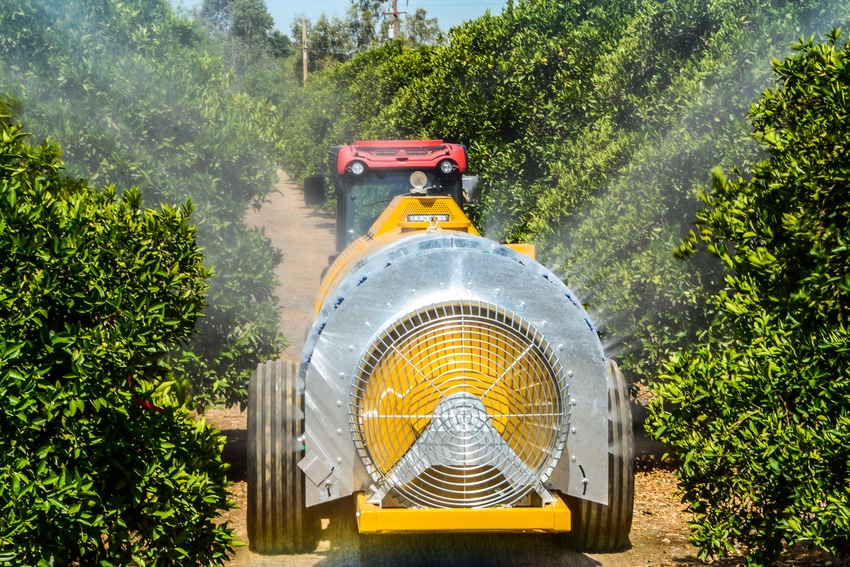
Challenges related to California red scale (CRS) in citrus may subside this year, according to one university specialist, since the weather which likely aided population growth was drastically different this winter.
Beth Grafton-Cardwell, research entomologist at he University of Riverside and director of the University of California’s Lindcove Research and Extension Center near Visalia, believes citrus growers could get an upper hand on CRS this season if they follow best management practices.
She says male CRS and those at the crawler stage are the only ones that move around. For the most part, the insect simply stays put, suggesting to apply insecticide treatments directly on the insect, which not only inhabits the fruit but can be found in large numbers on branches and in the wood.
According to Grafton-Cardwell, sampling is critical. Male CRS can be trapped on pheromone cards while the crawlers can be trapped on sticky tape attached to branches.
The UC specialist says trap cards can be used in two ways:
To follow the generations to determine when populations are changing; and,
At the end of the season to estimate overall population.
“Generally we have a distinct first flight, and then the crawlers follow the first generation,” she says. "Then there is a distinct second flight and then the crawlers follow. After this, it becomes a mishmash and that’s partly because the stages start overlapping.”
Temperature timing can be effective in knowing when population numbers rise and fall.
The last few years
Grafton-Cardwell believes drought and the relatively warm, dry winters seen the past several years in California helped push CRS populations higher.
“It was so warm in 2015 and 2016 that crawlers were emerging in January,” she said, adding that the females never went into diapause in those years.
“Normally the female’s diapause in November… and this shuts down until March,” she continued. “I’ve never seen that in 27 years.”
Treatments
Grafton-Cardwell says there are several treatment practices, each with their good points and shortcomings.
Aphytis wasp releases work on the second and third instars, but do not work well on adults or molts, she says. In some years these can be more effective than in others.
Dust control and pruning trees to open the canopy is important when using this wasp. Growers should avoid broad spectrum pesticides when using this method.
Petroleum oils also work well on the first instars of first or second generation CRS. Treatments during warm weather should be at night or in the early morning. She says orchards should be well-irrigated during treatment.
Grafton-Cardwell also recommends avoid combining petroleum oil applications with Aphytis control methods. This can work against Aphytis.
Organophosphates and carbamates are typically not used in the San Joaquin Valley due to resistance issues, she says. Even so, these products can be effective in targeting first or second generation at the white cap stage.
Though these can be highly toxic to natural enemies some have developed resistance to the class of chemicals and “can simply walk through organophosphates at this point,” she says.
Movento is applied as a foliar spray and targets the younger instar, but it “definitely needs an adjuvant,” she says. The good news is it's also effective on citrus red mite, citrus leafminer and citrus thrips. Note that Movento does not control scales on twigs and trunks.
Movento can be compatible with natural enemies, though it does affect predatory mites, the entomologist says, noting it's apparently non-toxic to predatory beetles and parasitic wasps.
Movento is not recommended to “clean up” high CRS populations.
Grafton-Cardwell has struggled with recommending neonicotinoids for CRS control because of the detrimental impacts they have on natural enemies. While systemic insecticides can effectively control CRS on fruit, the products don’t attack CRS in the wood. The end result is the pest will gradually build up populations there.
Control recommendations
Getting to early stages of CRS is the best control method because they tend to be more susceptible to the toxic effects of insecticides.
For this reason, Grafton-Cardwell recommends the following:
Timing – Apply pesticides at the stage most sensitive, and in tough situations apply multiple treatments;
Good coverage – 750-1,500 gallons per acre (gpa) for most chemical applications (read and follow label directions); or 250 gpa for Movento;
Calibrate spray rigs correctly and drive slowly – less than 1.5 mph to achieve good coverage; and,
Pheromone disruption – Suterra has dispensers that university studies show can reduce CRS populations by 50 percent in low-to-moderate infestations.
Some growers have developed a routine of applying Movento to thrips timing to get that first-generation suppression of CRS, and following that up with other products and treatments.
Insect growth regulators also can work in the first instar stage of first and second generation CRS. She says growers have tended to lean on Esteem over Applaud, as Esteem is perceived as more efficacious.
There are indications that resistance to Esteem is building, though she says she is having trouble proving this in the lab.
About the Author(s)
You May Also Like






